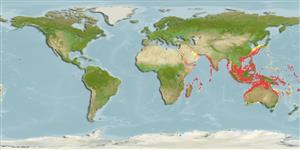Environment: milieu / climate zone / depth range / distribution range
Ecologia
marinhas associadas(os) a recifes; não migratória; intervalo de profundidade 10 - 300 m (Ref. 9790). Tropical
Indo-West Pacific: widespread, from the New Hebrides to Papua New Guinea, north to Taiwan, through Indonesia to Thailand, Pakistan, the Red Sea, and South Africa. Replaced by Cociella crocodilus from southern China to Japan and by Cociella hutchinsi in northern Australia (Ref. 37816).
Tamanho / Peso / Idade
Maturity: Lm ? range ? - ? cm
Max length : 35.0 cm TL macho/indeterminado; (Ref. 9790); common length : 25.0 cm TL macho/indeterminado; (Ref. 9790)
Descrição breve
Morfologia | Morfometria
Espinhos dorsais (total): 9; Raios dorsais moles (total): 10-12; Espinhos anais 0; Raios anais moles: 11 - 12. Uppermost preopercular spine reaching only about half-way to the opercular margin. Preorbital spine present. Infraorbital ridge usually smooth over anterior 1/2 of eye. Suborbital ridge lacking spines behind eye. Interopercular flap present. Iris lappet simple, semicircular. Numerous small dark spots on back reaching to below the lateral line, more widely scattered posteriorly. Has 5-6 dark bands across the back, but small juveniles may have only a broad saddle crossing the spinous dorsal fin and a narrow one near the rear of the soft dorsal fin (Ref. 37816).
Frequents shallow areas in depths of 10 m or less. Taken in trawl fisheries at depths from 23 to 250 m. Reported from a trap in the Gulf of Aqaba at a depth of 300 m. Young to juvenile stages utilize mangrove habitat (Ref. 9790). Adults occur in silty sand habitats from the shallows to a depth of 300 m (Ref. 37816). Also found in coastal sand patches, near coral reefs but more often on offshore (Ref 90102).
Life cycle and mating behavior
Maturidade | Reprodução | Desova | Ovos | Fecundidade | Larvas
Knapp, L.W., 1999. Platycephalidae. Flatheads. p. 2385-2421. In K.E. Carpenter and V.H. Niem (eds.) FAO species identification guide for fishery purposes. The living marine resources of the Western Central Pacific. Volume 4. Bony fishes part 2 (Mugilidae to Carangidae). FAO, Rome. (Ref. 9790)
Categoria na Lista Vermelha da IUCN (Ref. 130435)
Ameaça para o homem
Harmless
Utilização humana
Pescarias: pouco comercial
Mais informação
Nomes comunsSinónimosMetabolismoPredadoresEcotoxicologiaReproduçãoMaturidadeDesovaAgregação para desovaFecundidadeOvosDesenvolvimento dos ovos
Idade/TamanhoCrescimentoComprimento-pesoComprimento-comprimentoFrequência de comprimentoMorfometriaMorfologiaLarvasDinâmica larvarRecrutamentoAbundânciaBRUVS
ReferênciasAquaculturaPerfil para aquaculturaEstirpesGenéticaElectrophoresesHereditariedadeDoençasProcessamentoNutrientsMass conversion
ColaboradoresFotografiasStamps, Coins Misc.SonsCiguateraVelocidadeTipo de nataçãoÁrea branquialOutras referênciasCérebrosVisão
Ferramentas
Relatórios especiais
Descarregue XML
Fontes da internet
Estimates based on models
Preferred temperature (Ref.
123201): 18.8 - 28.1, mean 25.6 °C (based on 1088 cells).
Phylogenetic diversity index (Ref.
82804): PD
50 = 0.5312 [Uniqueness, from 0.5 = low to 2.0 = high].
Bayesian length-weight: a=0.00525 (0.00246 - 0.01120), b=3.04 (2.85 - 3.23), in cm total length, based on LWR estimates for this (Sub)family-body shape (Ref.
93245).
Nível Trófico (Ref.
69278): 3.8 ±0.7 se; based on size and trophs of closest relatives
Resiliência (Ref.
120179): Médio, tempo mínimo de duplicação da população 1,4 - 4,4 anos (Preliminary K or Fecundity.).
Fishing Vulnerability (Ref.
59153): Low vulnerability (25 of 100).
Nutrients (Ref.
124155): Calcium = 48.7 [24.6, 138.2] mg/100g; Iron = 0.602 [0.280, 1.395] mg/100g; Protein = 17.8 [15.8, 19.9] %; Omega3 = 0.164 [0.071, 0.465] g/100g; Selenium = 54.3 [25.3, 141.5] μg/100g; VitaminA = 80.2 [28.8, 224.0] μg/100g; Zinc = 1.08 [0.69, 1.65] mg/100g (wet weight);
